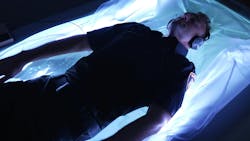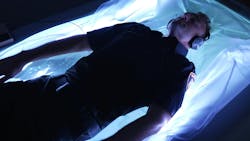How Do Head Injuries Affect Police? Ohio State Researcher Wants to Know
As any fan who has caught a sporting event—baseball, basketball, soccer and especially football—in the past 15 years will tell you, discussion of concussions and traumatic head injuries has dominated game broadcasts almost as much as talk of strategy or play execution. It’s been a far cry from the days when “getting your bell rung” was simply the price of doing business for an athlete at any level.
This article appeared in the January/February issue of OFFICER Magazine. Click Here to subscribe to OFFICER Magazine.
“Concussions really haven't been well-assessed and treated until pretty recently,” Dr. Jaclyn Caccese, an assistant professor at Ohio State University Wexner Medical Center’s School of Health and Rehabilitation Sciences, told OFFICER Magazine. “I would say even as late as the ‘90s, from a sports perspective. It was kind of, ‘Suck it up, throw some dirt on it and get back out there.’ ”
More on OFFICER.com
Study Looks at Head Injures in Ignored Area: Law Enforcement Officers
- A recent study by Ohio State researchers finds law enforcement officers who have had one or more head injuries were more likely to experience symptoms of depression and PTSD.
Attitudes started changing at the beginning of the 21st century as more and more aging former NFL players began reporting long-term health issues that some associated with head injuries, says Caccese. Research studies, Congressional hearings, lawsuits and a string of highly publicized suicides—former San Diego Chargers linebacker Junior Seau, former Chicago Bears safety Dave Duerson and former Atlanta Falcons safety Ray Easterling died of self-inflicted gunshot wounds; then-current Kansas City Chiefs lineback Jovan Belcher fatally shot his fiancée before killing himself—put a spotlight on concussions and chronic traumatic encephalopathy (CTE), the neurological disorder connected with repeated head injuries. In 2013, the NFL introduced its concussion protocol, and last year, players were allowed to wear Guardian Caps—oversize padded helmets that help minimize head impacts—in games for the first time.
“I think we've come a long way over the last three decades in the sports world,” says Caccese, who’s also an investigator with the Chronic Brain Injury Program at Ohio State. “But that knowledge and that awareness hasn't translated to other domains and occupations like first responders, who, in the line of duty, oftentimes are put in situations where they do experience concussions and other head injuries.”
That’s why Caccese—with the help of a U.S. Department of Defense grant—co-authored a study last year to look at the overlooked law enforcement population when it came to concussions. Researchers also generated recommendations for care management and return-to-duty protocols for officers, and Caccese hopes to build on the findings of this first-of-its-kind report, which was published in the Journal of Head Trauma Rehabilitation in August.
“I think it was just a problem that I think there's not an easy fix,” she says. “But I think there are steps that we could take to get better treatment for our officers, and they're out protecting us, so we really need to protect them.”
As part of the study, Caccese and her fellow researchers surveyed 381 central Ohio law enforcement members, asking about possible head injuries they had experienced in their lives. They found that 74% had reported one or more head injuries, and 30% had suffered an on-duty head injury. Over 50% of the respondents lost consciousness, felt dazed and confused or suffered memory loss following a head injury. Respondents who had suffered one or more head injuries also had greater symptoms of depression and post-traumatic stress disorder (PTSD).
“Part of what we’re doing with Ohio State is looking at, how can we extend the health of the deputy?” said Franklin County Sheriff’s Deputy Josh Walters in a statement at the time of the study’s release. Walters, a co-author on the report, leads a peer support group that has a long-term partnership with the university. “Being physically fit is an important part of our job because not only do my colleagues depend on me, but the community depends on me. And if I can’t physically keep up, then it could be a life-or-death situation for somebody.”
“This is an area where we have to improve awareness, just like we did in the sport concussion world,” Caccese added.
Recognizing your hurt
Nothing illustrated that need for increased awareness than one of the study’s troubling findings. Fewer than 1 in 4 head injuries was diagnosed or treated by a medical professional. Caccese notes that, like the NFL, law enforcement can have a “tough it out mentality” when it comes to dealing with pain and injury. But in conducting the study, she saw firsthand how the very public evolution of NFL’s attitude toward reporting head injures can move the needle among policing’s rank and file.
“I do think that the awareness, particularly in sports, really helps the message, helps the awareness,” she says. “I remember when we were doing, some of the first concussion education with officers here in central Ohio, and the one officer said, ‘You know, it makes perfect sense. I have to do concussion education for my 8-year-old's baseball team, but I never really thought how that applied to me.’ And so I think the awareness from the sports world… definitely helps.”
But in her interactions with law enforcement officers, Caccese found not only a need to put a spotlight on the symptoms that might indicate a concussion or other brain injury but also on the type of activities that might lead to them. Once she began diving into the details of what can happen during an officer’s typical shift, Caccese wasn’t surprised at the frequency of head injuries in law enforcement.
“I had been working in the sport-related concussion world for about a decade before we started doing anything with law enforcement and never really thought about law enforcement officers and the types of duties that they have and how they can be impacted by concussions,” she says. “But once I started chatting with officers, it wasn't as surprising as you might think that the rate of concussion is so high. … Although the numbers are quite alarming, after chatting with some officers, it's not altogether surprising that the rate is as high as it is.”
But what jumped out to an outsider’s perspective like Caccese’s, however, wasn’t always guaranteed to be as evident to a law enforcement officer. Unless consciousness was lost—which only happens in 5% to 10% of concussions—an officer might not feel a head injury was serious enough to require medical attention. And even then, unconsciousness wasn’t enough to set off any alarm bells following an injury.
“I chatted with one officer who fell down a flight of steps clearing a house and lost consciousness,” says Caccese. “But it wasn't until several days later that her partner even pointed that out to her.”
Recovering and returning to work
Awareness and attitudes, Cacesse and her team discovered, weren’t the only challenges to identifying and treating on-duty concussions and head injuries. The demands and circumstances of the job could, at times, potentially create obstacles. Officers don’t always have the luxury of stopping to get examined immediately after suffering an impact to the head.
“There are a couple things that help people recover better, faster,” says Caccese. “One is removing the person from the situation. Removal from play, for example, in the sports world. In law enforcement, that initial removal is a bit challenging.
“If you're out on the football field, and you get a concussion, and you're knocked out or something like that, we take you out of the game, and you don't go back into the game. In law enforcement, there are situations where they still have to finish, like if they're clearing a house or if they're chasing after some type of aggressor or something like that. They still have to finish their job. They can't just stop at that moment.”
And the signs of a concussion can be obscured by other physical responses during crises. Adrenaline can run high, says Caccese, and delay symptoms, like a headache. Even if an injured officer recognizes the tells of a head injury and seeks medical attention in a timely fashion, it might not to be the most effective way of doing it, she adds.
“A lot of times when officers are involved in some type of car accident, altercation or things like that, they'll go to the emergency department, and sometimes the emergency department is actually really bad at giving people a concussion diagnosis,” says Caccese. “Not because there's anything wrong with it. But if we think about the role of an emergency room physician, they're really looking for the bullet holes. They're looking for things that need immediate attention. And so sometimes they'll kind of say, ‘Well, you have a headache. See how it is over the next couple of days. If it continues, follow up with your primary care physician.’ As opposed to giving people truly a concussion diagnosis.
“I think it’s crucial, being aware of the kind of signs and symptoms of concussion and then also being your own advocate so that you could follow up with either your primary care physician or some type of concussion specialist so that you can get the appropriate diagnosis and treatment that you need.”
Ideally, injured officers would have a support system that also would be on the lookout for changes in behavior or other indications of a concussion. Caccese hopes law enforcement agencies can borrow from the sports world when it comes to managing the treatment of these types of injuries. She contrasts an injured football player’s medical care to that of the average officer.
“If you think about an NFL player who gets a concussion, he's got the eye in the sky neurologist who's looking at the field on the sidelines,” she says. “He's got an entire medical staff, so when he gets a concussion, they're pulling him out right away. They're evaluating him. They're following him over the next couple of days to see how he's doing. They're using some novel treatment methods to improve his recovery. When you have a law enforcement officer—even an officer who's in an officer-involved crash—it's kind of up to them to determine, hey, is this serious enough for me to go to the emergency department or not? It's not like he has a whole medical staff that he can consult with on the sideline, so to speak.”
A person on the sidelines, as Caccese calls it, would make sure an injured officer wasn’t alone on an island when it came to treatment. That individual could help officers delicately navigate recovery and a return to active duty if they had to miss time for a concussion. In fact, going back to work presents its own set of challenges. How limiting are the symptoms? What does light duty entail for different officers in different roles? Can accommodations be made to allow an officer to return to work before they’re 100%?
“Sometimes it's a matter of having conversations with officers, with their supervisors, about what those options are,” says Caccese. “If you have a patrol officer who gets a concussion, and his symptoms have resolved at rest, but you need to stress the system to make sure that the symptoms have resolved not only at rest, but with activity. You can't really do that unless they spend some time back on duty. Could they ride along with a partner for a couple days and see how their symptoms are? And maybe at the end of the first day, their symptoms increase a couple points on a 10-point scale. But with repeated exposure and additional recovery, maybe then they're able to fully return to duty without a partner. So finding ways to make those return to duty protocols work for different organizations and also different roles within the organization”
Caccese notes that getting an injured officer back on duty doesn’t just provide a benefit for an agency. It can also be therapeutic for the officer, whose social network might be through work.
“f you take somebody off duty, they lose their outlet,” she says. “So it's about finding ways to allow people to do as much as they can comfortably do that doesn't provoke their symptoms … while still seeking treatment, whether it be mental health or even vision. Sometimes after a concussion, people might have problems with their shooting accuracy. So they might need some vision rehab, and can we give them that while they're doing other tasks that don't necessarily involve that.”
Psychological trauma of physical injuries
Now that law enforcement has become part of the public discourse on head injuries with the Ohio State study, Caccese and Walters want to build on the report’s findings to create law enforcement’s own concussion protocols. That includes applying their recommendations in the field and evaluating their effectiveness.
“Now we have some data that we can present to administrations, to unions, to leadership that says, ‘Here’s the problem. This is how we can fix it. Let’s start working that process,’” Walters said in August.
Caccese also wants to continue studying the field in order to identify factors unique to law enforcement. While the sports world provided a good jumping off point to begin looking at concussions in policing, it differs substantially in terms of how injuries are sustained and the mental stress then can inflict.
“If you think about a fight that breaks out or a stressful scenario where they're responding to a domestic violence call or something like that, there's psychological trauma that also occurs, kind of co-occurring with the brain injury,” says Caccese. “And we know from the military that that's a difficult combination. … I think that's something that we want to explore in the future, and we want to identify better treatment solutions that happens.”




